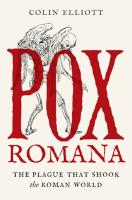
Princeton (2024) h/b 304pp £28 (ISBN 9780693219158)
Colin Elliott is Associate Professor in the Department of History, Indiana University, specialising in economic and social history, particularly in the early Roman Empire. His immediately previous book (2020) is Money, Capital and Inequality in the Age of Augustus. This book is the latest in the ‘Turning Points in Ancient History’ series organised by Princeton, where recent subjects have included the Fire at Rome under Nero and the invasion of Egypt by the Sea People in 1177 BC.
Perhaps the most striking feature of E.’s work is how he creates 300 pages of text out of a topic about which very little information is recorded and, of that meagre input, virtually nothing is known for certain. Where the epidemic began, its epidemiological characteristics, how it spread, its mortality rates and when it ended are all wholly debatable.
One of the purposes of the Princeton series is, however, to explore fresh interpretations of each event and E. uses the opportunity to explore why Gibbon was wrong to identify the Antonine period as the peak of Roman Civilisation. ‘If a man were called to fix the period in history of the world in which the condition of the human race was most happy and prosperous, he would without hesitation, name that which elapsed from the death of Domitian to the accession of Commodus’.
His argument is that several serious fault lines had started to emerge in the imperial economy well before the epidemic and that the main effect of the epidemic was to expose and intensify those fault lines. The precise contribution of the epidemic to this exposure is consequently relatively unimportant compared to the lasting effects of the fault lines themselves. As indeed in our recent Covid experience, societal changes like working from home and buying online were intensified but not created by the epidemic.
To deal with the epidemic first: it broke out in the Roman empire in the Middle East in AD 165/6, just after the armies had completed a successful campaign against Parthia—although there may have been an outbreak a decade earlier in China. It was almost certainly not bubonic but more likely came from the poxviridae family. It spread with human contact and reached Rome in the autumn of 166 when at least one legion celebrated a triumph. Other victorious legions trudged back to Northern Europe. It spread fastest in cities and within the armies. It could be deadly, but mortality rate estimates vary widely—from 1% to 35% of the total population. Galen who was in Rome at the time advising the emperor, failed to describe the symptoms in sufficient detail to be useful, which is pretty rich coming from a man who criticised Thucydides’ description of the Athenian plague as more that of a historian than of a medic. The epidemic probably petered out by the end of the 170s but may have returned to Rome for a last hurrah in 190. No effective cure was identified but the authorities claimed that the gods were angry because of disregard and disrespect and accordingly rounded up some suitably dissident scapegoats, including Christians, to offer up as propitiatory sacrifices.
The most potent of the pre-epidemic fault-lines which E. identifies is the low resilience to shocks which had developed in urban areas, particularly in Rome, due to poor nutrition and appalling living conditions which intensified the effect of the plague. The previous decade had also experienced low economic activity which stretched the emperor’s ability to pay bonuses to the army or to raise its pay in line with inflation. Further, in order to maintain an adequate and affordable grain supply in a period when the Nile intermittently failed to flood optimally, the authorities had devised a system which interfered with the free market to such an extent that land values in Egypt fell significantly. In geopolitical terms the tribes in the east were already beginning to put pressure on the tribes immediately to the east of the Rhine. The army’s lack of success in the Marcomanni wars of 166-180 was undoubtedly at least partially due to the loss of life within the legions caused by the epidemic and the inability readily to find replacements because of mortality rates elsewhere. Evidence from retirement plaques suggest that relatively few soldiers survived to retirement age in the next two decades.
E. undoubtedly makes a plausible case for his claim that the epidemic was an important reason but not the only, nor even the main, reason why the empire subsequently drifted into decline. His case is weakened by the absence of hard material with which to apportion the relative importance of the many direct and indirect effects of the epidemic which he describes. Causality is also hard to identify and ‘may’, ‘perhaps’ and other conditionals abound.
E.’s style of writing is dense but is admirably jargon and prejudice free—although he is clearly a subscriber to the current ‘imperial capitalism is a bad thing’ consensus. There are 26 pages of notes which largely refer the reader on to a 28-page bibliography. There are also a couple of maps and several statistical tables.
The Princeton team advertise this series as written for the general reader rather than by academics for academics. This book falls rather between those two stools. Being understandably not a linear temporal description of the event itself, but an examination of various topics surrounding the event, the text is occasionally repetitive and difficult to tie into the main thesis. The passages describing the interesting statistical tables can read like cut down versions of articles from a learned journal. The book will probably not appeal to an epidemiologist, but the CfA reader with £28 to spare might well find the alternative interpretation advanced stimulating.
Roger Barnes
